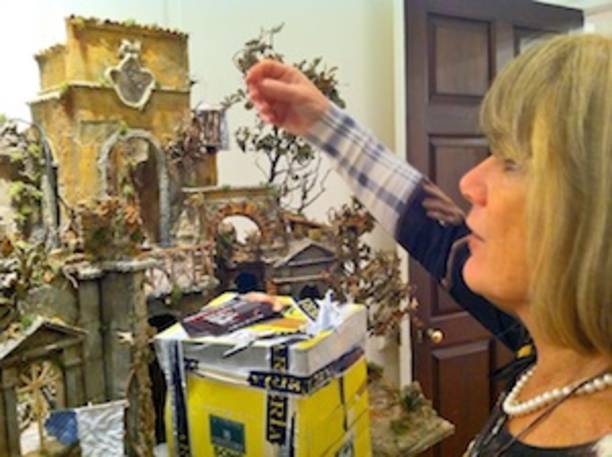


One of the most beloved Italian Christmas traditions is the presepe.
The representation of the nativity is so important in the Italian culture that often it has been included and emphasized in cinema and theater. One example above all is Cupiello’s Presepe that plays a central part in the theatrical comedy Natale in Casa Cupiello [2] by Eduardo De Filippo [3]. In this piece, the Presepe becomes the symbol of the entire family tradition, first snubbed and then embraced by Cupiello’s son.
The origin of this tradition dates back to Saint Francis, who created the first Presepe with real people in 1223. This form of art, however, has been mastered over the centuries, since the 1500s, by the Neapolitan masters, leading to the famous Presepe Napoletano, characterized by clay figurines and highly detailed and elaborated settings (scogli).
The Neapolitan Presepe is now regarded as a true form of art; as such, an event to celebrate this tradition was long due. And finally the wait is over: Americans will be able to enjoy some incredibly charming presepi, both modern and historical, at an exposition held at the Italian Cultural Institute [4] from December 14 2010 to January 18, 2011.
During the installation of this event i-Italy was granted a sneak peak at the pieces and an interview with Filomena Maria Sardella - curator of the exhibit and part of the Direzione Regionale dei Beni Culturali e Paesaggistici della Regione Campania (The cultural bureau of Campania Region) - who explained the evolution of the Neapolitan presepe.
It began in the 1500s, when Master Gaetano di Thiene [5] (Saint Cajetan) started to include in the representation more intimate figures from everyday life. Up to then the presepe was a mystical representation of the nativity scene, with only the canonical characters such as Baby Jesus, the Virgin Mary, the angels etc. Gaetano di Thiene included more common characters such as shepherds, effectively creating a new trend: the presepe became more representative of real life and of the customs of Neapolitan society. This new trend gradually increased in importance, and even leaked into figurative arts, reaching its climax during the baroque and rococo periods (1600s and 1700s) when characters such as the washerwoman, the cripple, the moor, and many others were included in the representation. This trend never faded, and even today popular characters even from cinema or politics are included in the presepe. In the 1960s Totò made his appearance; the same, more recently, happened to politicians such as Di Pietro, Mitterrand and even Bill Clinton.
During the baroque period the presepe went through another evolution: up until then it had been staged only in religious buildings, but the aristocracy took interest in this art and at that moment the presepi began to appear in the palaces of the rich and powerful Neapolitan nobility. It is well known that king Charles de Bourbon [6] was an avid enthusiast of the presepe, so much that he liked to personally set the characters in the scoglio and had the queen and court damsels craft the garments to be used out of the finest silks.
The presepe became so popular that in the late 1700s shops even sold miniature jewels to ornate the figurines.
Since then the presepe has gone through many evolutions. One of the most curious is the miniature presepi, such as the ones set into chestnut shells or seashells, or the one which will be on view at the exhibition which is 15” high and includes over three hundred characters. By definition this form of art is always changing: every year, even if the scoglio remains the same, the characters are arranged differently, new figurines are brought in and old and damaged ones are substituted.
Nowadays most Italian families celebrate this tradition every Christmas. As a result, this art is probably the most practiced in Italy (after cooking), and the setting up of the presepe is an extremely heartfelt moment of the festivities, when the entire family gathers together and celebrates Christmas. In 1954, AIAP (the Association of Presepial Artists) was founded in order to preserve this tradition, and of course the Neapolitan branch of the association is the most active.
The exhibit will feature nearly forty pieces, among which a cart that is part of the royal family's presepe on display at the Royal Palace of Caserta [7]. The exhibition will be inaugurated on December 14 at 6 pm. This will be a unique opportunity for New Yorkers to discover and appreciate this fascinating Italian tradition, and maybe even to make their own presepe.
Source URL: http://test.iitaly.org/magazine/events/reports/article/neapolitan-presepe-where-art-religion-and-popular-culture-come
Links
[1] http://test.iitaly.org/files/signorajpg
[2] http://it.wikipedia.org/wiki/Natale_in_casa_Cupiello
[3] http://en.wikipedia.org/wiki/Eduardo_De_Filippo
[4] http://www.iicnewyork.esteri.it/IIC_Newyork
[5] http://en.wikipedia.org/wiki/Saint_Cajetan
[6] http://en.wikipedia.org/wiki/Charles_III_of_Spain
[7] http://en.wikipedia.org/wiki/Palace_of_Caserta